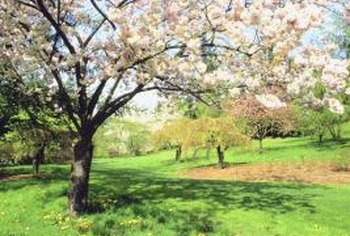Not all tree graft to any other tree.
Compatible Fruit Tree Grafting
Related Articles
Fruit trees of the same genus but different varieties are compatible for grafting. Grafting joins a lower rootstock portion of a fruit tree with the scion portion of another variety of fruit tree. Rootstocks of dwarf or semi-dwarf trees are often grafted onto standard growth trees to create manageable trees for the home orchard. Semi-dwarf rootstock is most frequently used as graft material, producing trees 12 to 18 feet in height.
Compatible Varieties
Nearly all citrus varieties are compatible with each other for grafting. Any two varieties of fruit trees in the Prunus genus such as apple, cherry, and plums also do well when grafted together. European pear (Pyrus communis) rootstock is compatible with other varieties of European and Asian pear( Pyrus calleryana, P.ussuriensis). Peach (Prunus persica) rootstock is compatible with other varieties of peach, nectarine (P. persica var. nectarine), European plum (Prunus domestica), plumcot (P. domestica x armenica) and apricot (Prunus armeniaca). Quince (Cydonia oblonga) is compatible with all varieties of quince, pear and loquat (Eriobotrya japonica) trees.
Choosing Rootstock and Scion
The best rootstock to use for grafting is one year old with a diameter of approximately three-eighths inch. Rootstock diameters over one-half inch are likely to send up sprouts of growth from underground, rather than unite with the scion. Select pencil-thick and pencil-length fruit tree scions taken from the parent tree during its dormancy to use for cleft grafting.
The Mechanics of Grafting
Grafting is successful when the living tissue layer, or cambium, of the rootstock and the scion grow together. Clean, sharp tools help prevent the spread of disease into the raw grafting cuts. The living tissue must also be kept clean and protected after it is grafted. There are many methods of grafting, but cleft grafting is most frequently used by beginning grafters. A scion branch cut on the diagonal is inserted into a straight-cut rootstock with a split in the middle. A sloping cut is made on each side of the scion, matching the cambium tissue as it is inserted into the rootstock.
Care of the Graft
Proper care of the grafted area is essential to successfully join the portions of tree. The cambium tissue begins to grow together when it is protected from disease and weather by wrapping it with nurseryman's tape. All exposed surfaces of the graft are covered with the tape, except the area where the scion is inserted and the scion itself. Pruning paint applied to exposed surfaces, including the wrapped area, will further protect the graft wound. Polymer paints are not recommended, because the chemical content interferes with graft wound healing. This secure covering and protection are left for three months and then removed.

